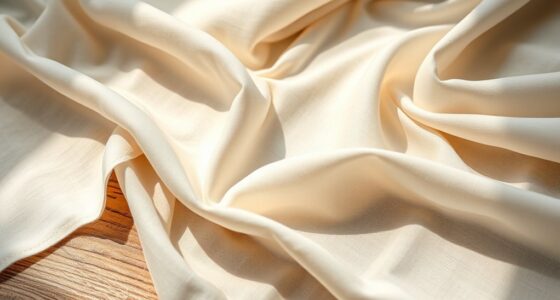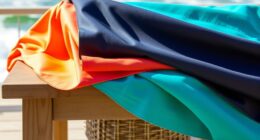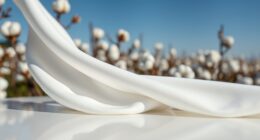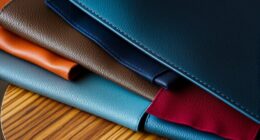If you’re starting your journey into sustainable fabrics, begin with options like bamboo, which grows quickly with little water or pesticides, and lyocell, made through eco-friendly processes that recover and reuse chemicals. These fabrics reduce environmental impact and create durable, stylish garments. To make smarter choices, look for brands emphasizing transparency and green production methods. Keep exploring to discover more about incorporating eco-conscious materials and techniques into your wardrobe for a greener future.
Key Takeaways
- Start with sustainable materials like bamboo and lyocell, which require fewer resources and have eco-friendly production processes.
- Understand eco-friendly dyeing techniques, such as plant-based dyes and digital printing, to reduce water use and eliminate harmful chemicals.
- Incorporate circular fiber strategies by designing for durability, repairability, and recyclability to minimize textile waste.
- Choose brands committed to transparency, eco-conscious manufacturing, and the use of sustainable fabrics like bamboo and lyocell.
- Support and advocate for the adoption of sustainable fabrics and practices to promote a greener, more ethical fashion industry.
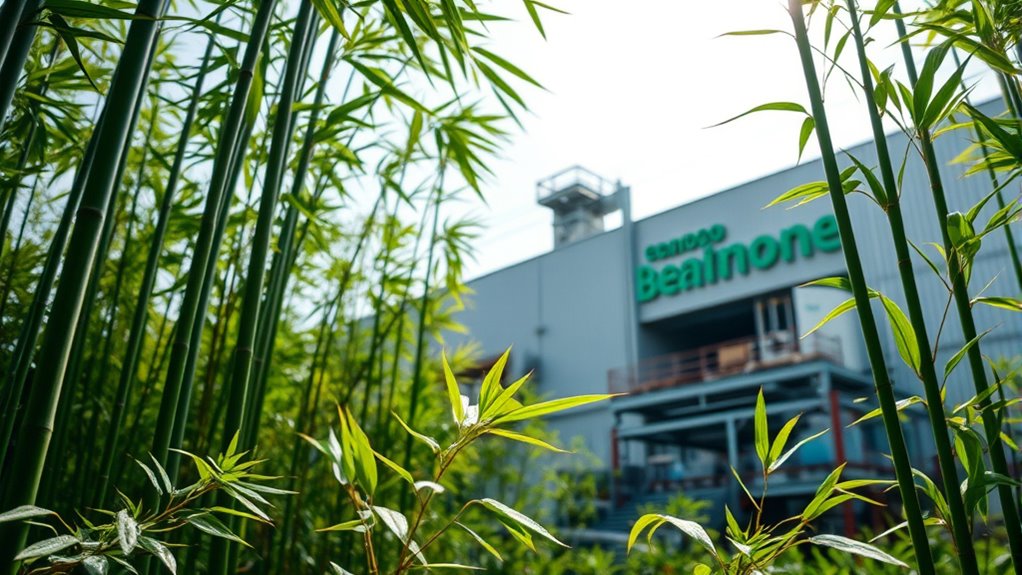
As the fashion industry faces increasing pressure to reduce its environmental impact, developing a clear roadmap for sustainable fabrics becomes essential. You’re likely exploring options that minimize harm to the planet while still offering stylish, durable garments. One of the first steps is understanding eco-friendly dyeing techniques. Traditional dyeing uses large amounts of water and chemicals that pollute waterways and harm ecosystems. Eco-friendly dyeing methods, such as plant-based dyes or digital printing, substantially cut down on water use and eliminate toxic substances. These techniques not only reduce environmental harm but also appeal to conscious consumers seeking transparency and sustainability in their clothing choices. By choosing fabrics that support eco-friendly dyeing, you can help promote cleaner production processes and a more sustainable fashion industry.
Eco-friendly dyeing techniques reduce water use and eliminate toxic chemicals, promoting sustainable fashion choices.
Another vital aspect is circular fiber use, which aims to keep textiles in continuous use and waste out of landfills. Instead of following a linear model—where fabrics are produced, used, and discarded—you focus on designing garments for longevity, repairability, and recyclability. Circular fiber use involves selecting fabrics made from renewable or recyclable materials that can be repurposed at the end of their life cycle. For example, some fabrics are designed to be easily recycled into new fibers, reducing the need for virgin raw materials. This approach helps conserve resources and minimizes waste, making your clothing choices more sustainable. By prioritizing circular fiber use, you contribute to a closed-loop system that lessens environmental impact and supports a more sustainable fashion ecosystem.
Starting with materials like bamboo, which regenerates quickly and requires little water or pesticides, makes a solid foundation. Then, shifting toward fabrics like Lyocell, produced via environmentally friendly processes, further enhances your sustainability efforts. Lyocell is made using a closed-loop process that recovers and reuses solvents, drastically reducing chemical waste. When combined with eco-friendly dyeing methods and circular fiber strategies, these fabrics form a complete approach to sustainability. Incorporating innovative manufacturing techniques can further reduce energy consumption and environmental impact throughout the production cycle.
You don’t have to overhaul your entire wardrobe overnight, but understanding these core concepts helps guide smarter choices. Seek out brands that prioritize eco-friendly dyeing and circular fiber use, and advocate for transparency in their supply chains. By doing so, you’re helping create demand for greener fabrics and encouraging the industry to adopt more sustainable practices. Remember, every conscious purchase pushes the industry closer to a future where fashion and sustainability go hand in hand. Your choices matter, and with informed decisions, you can be part of the movement toward a more sustainable, ethical fashion world.
Frequently Asked Questions
How Do Sustainable Fabrics Compare in Cost to Conventional Textiles?
You might notice that sustainable fabrics often have a higher cost compared to conventional textiles. The cost comparison is influenced by pricing factors like raw material availability, production methods, and scale. While sustainable fabrics can be pricier initially, they may offer long-term savings through durability and eco-friendliness. Ultimately, investing in sustainable fabrics supports environmental goals and can align with your values, even if the upfront price is higher.
Are Sustainable Fabrics as Durable as Traditional Materials?
You might wonder if sustainable fabrics match traditional materials in durability. Generally, durability comparisons show that many sustainable fabrics, like Tencel or hemp, hold up well with proper care. However, brand transparency is key—some brands clearly disclose their fabric quality and testing, helping you choose more durable options. While some sustainable fabrics are just as durable, always check product details and care instructions to guarantee your investment lasts.
What Are the Main Environmental Impacts of Bamboo and Lyocell Production?
You might think bamboo and lyocell are eco-friendly superheroes, but their environmental footprint tells a different story. Bamboo’s water consumption can be surprisingly high, and both materials often require chemicals during processing. While they’re touted as sustainable, they still impact water resources and pollute if not managed responsibly. So, don’t be fooled—true sustainability needs careful consideration of water use and chemical impacts in production.
Can Sustainable Fabrics Be Recycled or Composted After Use?
You might wonder if sustainable fabrics can be recycled or composted after use. Many, like bamboo and lyocell, have end-of-life options that include recycling or composting, thanks to their biodegradable potential. These fabrics can often be broken down naturally, reducing waste and environmental impact. Always check specific care instructions, but generally, choosing fabrics with good end-of-life options helps you minimize your ecological footprint and supports a more sustainable future.
How Can Consumers Verify the Eco-Credentials of Fabric Brands?
To verify a fabric brand’s eco-credentials, start by checking their certification standards like GOTS or OEKO-TEX, which ensure sustainable practices. Look for transparency reports that detail their sourcing and manufacturing processes. You can also research third-party audits and reviews. By doing this, you ascertain they genuinely prioritize sustainability, helping you make eco-conscious choices and support brands committed to environmental responsibility.
Conclusion
Think of choosing sustainable fabrics like planting a garden—you start small, but with care, your efforts grow into a vibrant, eco-friendly landscape. For example, switching to bamboo or lyocell can markedly reduce water and chemical use, much like watering your plants without overdoing it. Every conscious choice you make is like nurturing a seed that blooms into a greener future, proving that even small steps can lead to a beautiful, sustainable world.





